Ice fishermen likely fall into two categories: those with strong opinions about which baits are best to use and those who will fish with just about anything. You will get varying answers from both groups when deciding what bait to use.
For most cases, using minnows will be the most suitable catch-all option for ice fishing with live bait and will work in almost any scenario. Choosing the best live bait for ice fishing can be daunting and may vary based on the targeted species and fishing conditions.
While minnows might not be the best live bait in every circumstance, they are never the wrong choice to use and are likely to catch you a fish no matter where you’re fishing.
Why Minnows Are The Best Live Bait For Ice Fishing?
There are dozens of different live baits to choose from for live bait ice fishing, and saying that one is the best can be a divisive statement, but no angler will say that minnows are a poor choice.
Below are several reasons why minnows are such effective bait for ice fishing and why you can never go wrong choosing minnows for your live bait needs.
Also, you might want to know: Do You Really Need Live Baits for Ice Fishing?
1. Minnows Are Readily Available
Of all the live baits available for ice fishing, few are as widely available as minnows. While some insects might be seasonally or regionally dependent, minnows are nearly always stocked at tackle stores.
Minnows are incredibly popular to use while ice fishing which is another reason stores are likely to stock them.
While they might require more space for the tackle shop to stock them because of the need for large water tanks, most places have made accommodations to keep minnows stocked.
Minnows face high demand, so while stores are likely ordering them on busy weekends, you might find them sold out, so this is something to consider.
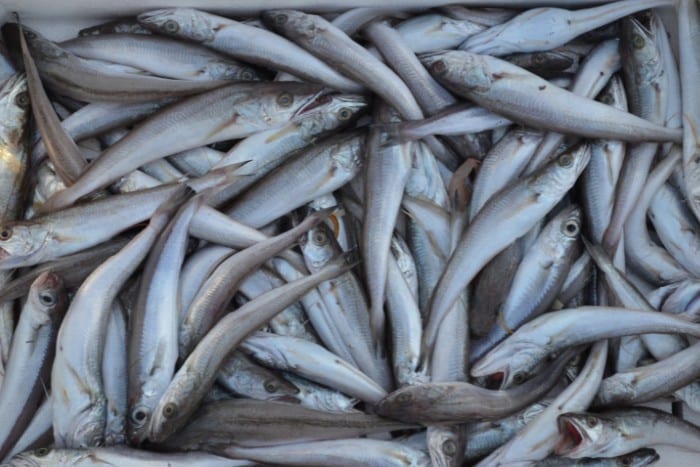
2. Minnows “Match The Hatch” For Most Fish
Part of what makes minnows such great bait is small fish are one of the main parts of predator fish diets during the winter.
Winter can be challenging to find food for fish, so a single fish is preferred to eating many insects for the same calories.
The minnows sold for ice fishing bait might not be the same species as those in the water you are fishing, but they will be similar enough to trick the predator fish into thinking nothing is off.
Injured minnows are especially tempting for fish looking for an easy meal during winter.
3. Minnows Offer More Action In The Water Than Insects
Sometimes predator fish need to detect plenty of thrashing movement in the water in order to investigate, something you can’t get with insects.
Minnows, however, will provide that swimming/struggling movement that drives fish wild.
The action you get from minnows varies depending on where you hook them and whether or not you use an additional lure.
Different fishing methods with minnows will be covered in more depth in the next point, but it’s important to note that you can get a lot of other movements from them to change things up when the fish aren’t biting.
4. Minnows Can Be Fished In Many Different Ways
Depending on what fish you are trying to attract and even what mood the target fish are in, you can change how you fish minnows to trigger a bite.
Fishing with minnows can be done with additional lures, jigging, or as bait in a tip-up.
A popular way of fishing with minnows is attaching them to a spoon, with the extra vibrations and movement of the spoon attracting fish from a further distance.
The combination of live bait and a lure can represent a school of fish, prompting more fish to investigate.
Don’t forget to check out my article on: How To Attract Fish While Ice Fishing?
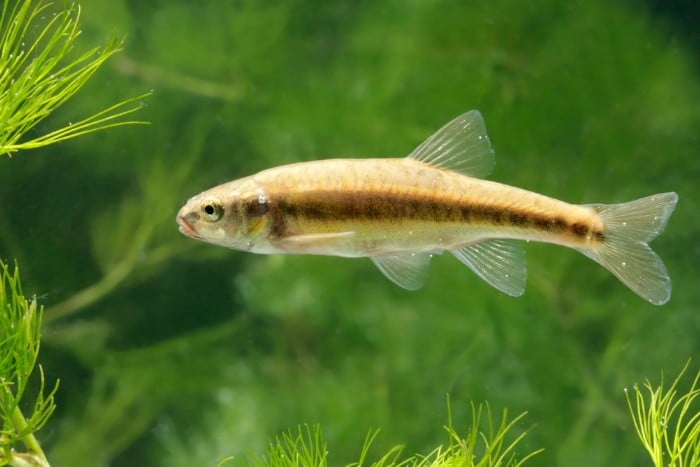
5. Minnows Come In Different Sizes
“Minnows” is a very broad name for small freshwater fish, and you may see them marketed as shiners, suckers, goldens, and many more names.
Sizes can range from an inch long to seven or eight inches on the large size.
This wide range of sizes offers plenty of selectability for your specific needs. Remember, bigger is not always better, and choosing a smaller size will result in more bites from fish of all sizes.
Even if you are chasing trophy-size walleye and pike, a 4” minnow might serve you better than a 7” minnow, and if you are going for quantity, smaller bait will always be the best option.
6. Minnows Are Perfect For Tip-Ups
Suppose you like to use several tip-up traps while ice fishing; minnows are the best option for you.
If you don’t know about tip-ups then my article on What are Ice Fishing Tip-ups will help you cover the basics.
A properly hooked minnow will swim around, causing commotion like an injured fish that will be impossible for nearby game fish to resist.
Since tip-up traps are designed to be left alone, having a bait fish that does most of the work is hard to beat and can significantly improve your odds of hooking a fish.
The minnows’ health will affect how long they last on the tip-up, but healthy fish can last an hour before needing to be replaced, giving you plenty of chances to catch a targeted species.
7. Minnows Can Be Fished Whole Or Cut
Minnows are versatile because you can fish them as live bait, dead bait, or even cut bait if you aren’t having luck. Using cut bait can be especially effective when fish are being finicky.
Ice fishing requires finding the right combination of bait and technique on difficult fishing days, while some days, the fish might be biting anything that moves.
Live bait usually performs very well, but you might need to try something else occasionally.
8. Minnows Have A Natural Scent That Drives Fish Crazy
Smell is a powerful sense for fish and can account for a large portion of their attraction to your baits.
Live baits are great at covering up human scents that might scare fish away, and minnows have a particularly strong smell.
A hooked minnow will release distress pheromones and blood into the water, further driving a predator fish’s reaction toward the injured fish.
This extra bit of attraction can bring fish in from further away and increase your odds of getting a bite.
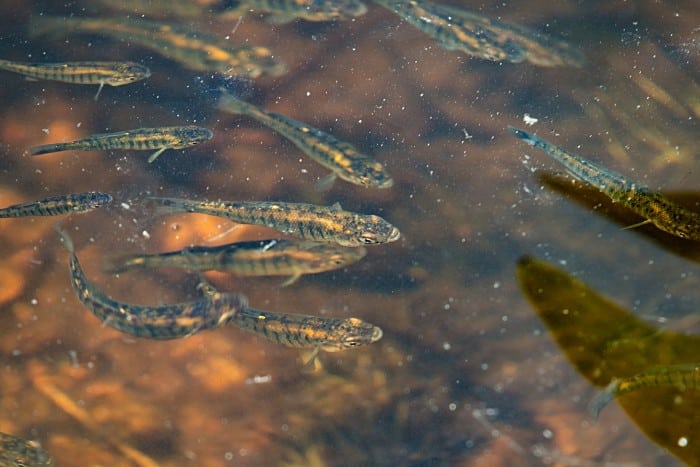
How To Hook Minnows For Ice Fishing?
Using a minnow as live bait for ice fishing is effective, and depending on how you hook the bait, you can achieve different results.
When choosing a hook size for ice fishing, always downsize from what you would use for summer fishing.
1. Hook The Minnow By The Lips
Lip-hooking the minnow is one of the best ways to hook a minnow to get the most action from them.
By hooking through the bottom of the jaw and out the top of their mouth, you can get the most secure hook, but going only through the top will increase how long the minnow is alive.
You can use a weighted live bait jig to control the depth of the minnow and limit how much it can swim around, which some predators will prefer to secure an easy meal compared to one swimming in circles.
Using a weighted jig also allows you to jig the live minnow and apply a more controlled movement, which can be vital in getting tricky fish to bite.
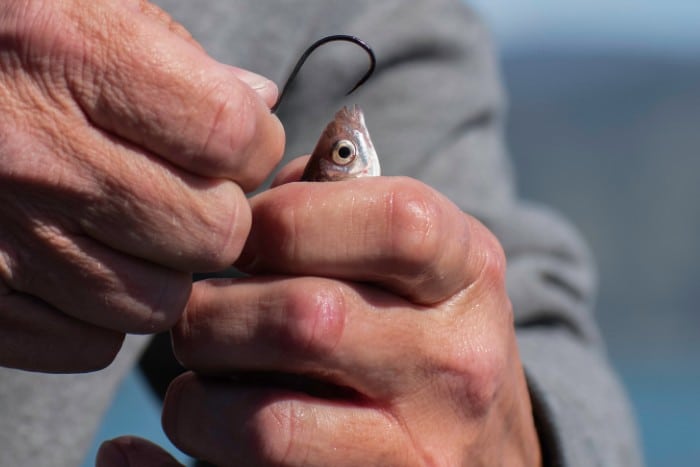
2. Hook The Minnow In The Back
Dorsal hooking a minnow is done just behind the top fin, being careful not to go too deep and hit the spine.
This method allows the minnow to swim naturally and is the easiest way to rig a minnow for beginners.
Dorsal hooking is the best method for baiting tip-ups for the same reason, giving the minnow the most natural movement to entice those targeted game fish.
Make sure to have the hook pointed towards the head of the fish for the best odds to set the hook.
You can use two treble hooks on a large minnow placed on either side of the dorsal fin for another rig option known as a quick strike rig.
This method works well for muskies and other large game fish.
3. Hook The Minnow Through The Tail
Tail hooking a minnow is the least popular method, but it is the best method for deep water presentations.
Tail hooking is also best for catch-and-release fishing because it limits the amount of gut hook you’ll get.
Hooking through the tail is best done with small minnows, as larger minnows are more likely to be ripped off the hook when the fish takes the bait.
4. Use The Minnow On A Jig For Added Movement
Known as tipping the lure, you can place a minnow on the end of a jig, spoon, or any other you like. The combination of live bait and a flashy lure can have great results and entice even the pickiest fish to bite.
Dead minnows can be used on the end of a jig if something happens to your live bait, so bringing some spoons and jigs with your live bait will give you a backup plan.
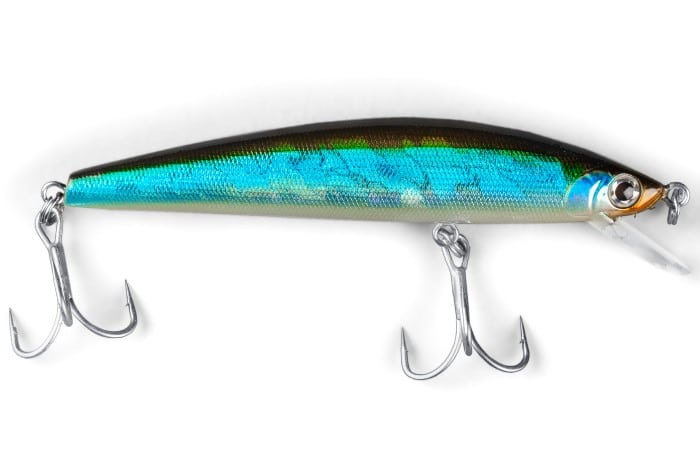
5. Choose The Right Hook
Small minnows need a small hook, such as a #8, which allows the bait to swim freely and as naturally as possible. Larger minnows can be stepped up to a size #6 or #8, depending on the size of the minnow.
Baitholder and octopus hooks are the most popular style single hook for minnows, and octopus hooks are especially great for larger-size bait.
Treble hooks are also great for ice fishing and can increase your hook up ratios, especially when hooking a minnow through the back.
9 More Baits That Are Great For Ice Fishing
While minnows might be one of the best live baits for ice fishing, many options are available.
Minnows require a bucket and bubbler for best results, and many of the options on this list are easier to use and require less equipment.
If ease of use is your primary concern, or your local bait shop is sold out of minnows, then choosing a live bait from this list will still serve you well.
1. Spikes
Spike is just another name for maggots, one of the most popular live baits. Many anglers start with spikes and have plenty of success with them.
Spikes are small compared to many other bait options, so you may need to tip your hook with two or three of them to have enough presentation for the fish. Spikes are also great for tipping lures.
2. Nightcrawlers
Nightcrawlers are a staple for summer fishing and are a little less active in cold water but are still an excellent option for ice fishing.
Nightcrawlers are inexpensive but can be challenging to find during winter in some areas, which can be a drawback.
One reason that nightcrawlers can be ineffective bait during winter is that worms rarely get washed into the water, and the fish can grow weary of them.
3. Wax Worms
Wax worms, or “waxies,” are commonly sold at tackle stores for ice fishing and work well for panfish and trout.
Wax worms offer a unique scent and are different enough from other live baits to differentiate you if other anglers use spikes.
Switching up live baits when many anglers use one or two types can result in a considerable boost in bites, so bringing two different options is always a good idea.
4. Wigglers
Wigglers are the smaller earthworm variety compared to nightcrawlers and will perform similarly as well.
Since downsizing baits is an effective strategy during ice fishing, changing from nightcrawlers to wigglers can result in better luck fishing.
Other than the slightly smaller size than nightcrawlers, wigglers are identical, so you can rig them the same as larger worms, although you may need a smaller hook.
5. Mealworms
Mealworms are usually sold as pet food in addition to being marketed as fish bait, so if your local tackle shop is out of stock, pet stores are likely to have them in stock instead.
Mealworms keep well in the fridge or the cold weather, so you don’t need to be in a hurry to use them all in a single trip.
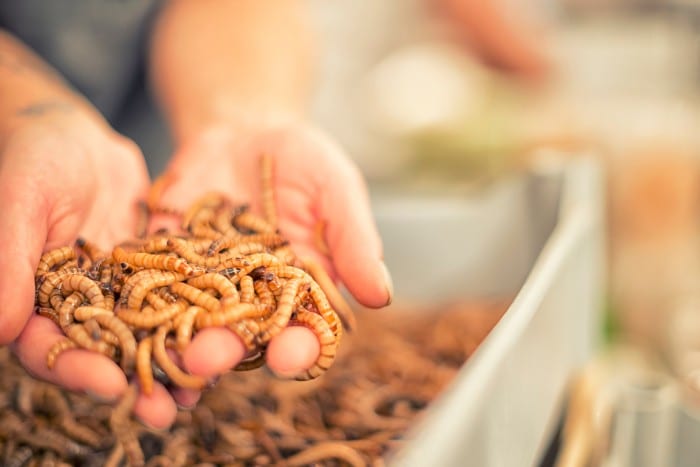
6. Mousies
Mousies are the common name for rat-tailed maggots thanks to their thin tail coming off their maggoty body. This extra bit of action is unique and drives fish insane when you can find mousies for sale.
Mousies are best for small fish species, including panfish but can still be adequate for larger fish.
7. Cut Bait
If you’re only catching dinks, you can use them as cut bait to increase your odds of catching bigger fish. The legality will vary from state to state, so confirm that cutting bait is allowed.
While this bait might not technically be “live bait,” anglers might overlook cut bait during ice fishing season.
8. Artificial Lures
You can use artificial lures with live bait or standalone, so even if you plan on using live bait, packing a few lures is an excellent strategy to switch things up if the fish aren’t biting.
Having several options available when fishing is key to narrowing down on what the fish are biting on, so make sure to bring several options.
Conclusion
Ice fishing with live bait can be very productive, and few live baits are as versatile as using minnows.
Coming in different sizes and having a variety of ways to use them can play a huge role in whether you end up catching a limit.
Other live baits are also great for ice fishing, including spikes, mealworms, earthworms, mousies, and wigglers. And sometimes live bait does not work, so switching it up can play to your advantage.
